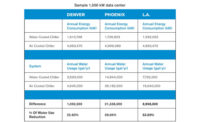Today’s data centers handle an increasing volume of global digital communication traffic compared to their predecessors of yesteryear. The computers and digital devices that provide streaming video, Internet of Things (IoT) data, business communications, etc. are driving the growth of new data centers to handle this traffic. The advent of 5G networks promises a huge jump in mobile device bandwidth and will accelerate the growth of data centers and their associated 24/7 cooling demands.
Concerns about the high levels of power consumption by data centers have led the industry to improve operating efficiencies and establish metrics to track progress. One well-known metric is power usage effectiveness (PUE), which is the ratio of the total power usage of a data center to the power usage of its IT equipment only (a lower value is better). According to the Uptime Institute, PUE improved significantly from 2.5 to 1.65 from 2007 to 2013; however, the rate of improvement in PUE has slowed more recently with an overall score of 1.58 in 2018. One area where further energy savings may be realized, with consequent reduction in PUE, is with improvements in data center air-handling efficiency. With the trend toward free air cooling, a large percentage of non-IT energy is used by air-handling cooling systems. Even where direct expansion (DX) air conditioning is used, air movement still accounts for a large portion of energy usage.
Arrays of direct-drive plenum fans are commonly used to move air for data center cooling. Each plenum fan is rotated by an electric motor, and typically the motors are operated with a VFD to provide variable-speed operation. Air movement in data center cooling is typically non-ducted; large volumes of air are moved at relatively low static pressures. While actual requirements vary between facilities, typical characteristics of an individual plenum fan in a large array would be air delivery of 12,000 cfm in an environment of 1-inch static pressure water gauge (w.g.).
Fan Selection
Table 1 shows different plenum fan options that provide an airflow of 12,000 cfm at a static pressure of 1 inch of w.g.
|
Fan Diameter |
Air Flow |
Total Static Pressure |
Fan Speed |
Power |
Fan Efficiency |
|
inches |
CFM |
W.G. |
RPM |
BHP |
Percent |
|
36 |
12,000 |
1.00 |
569 |
2.56 |
74% |
|
33 |
12,000 |
1.00 |
716 |
2.78 |
68% |
|
30 |
12,000 |
1.00 |
943 |
3.20 |
59% |
|
27 |
12,000 |
1.00 |
1,151 |
3.71 |
51% |
|
24 |
12,000 |
1.00 |
1,463 |
4.32 |
44% |
|
22 |
12,000 |
1.00 |
2,167 |
6.59 |
29% |
Table 1: Plenum fan options (data courtesy of BasX Solutions).
Table 1 illustrates that in a low static pressure environment, demonstrating that significantly higher fan efficiency with potential system energy savings can be achieved by selecting a larger diameter fan operating at low speed (near 600 RPM in this example).
Fan Motor Selection
To achieve high system efficiency, the electric motors that operate the fans must also provide efficient operation at the low speeds demanded by the optimized fans.
Gearing as a Possible Approach
One control option is a geared system such as a belt and pulley arrangement, whereby an electric motor is operated at a higher speed in its efficient operating range and geared down to deliver the required low fan speed. For example, one could envision an 1,800-RPM, four-pole induction motor and a 3:1 belt and pulley system to rotate the fan at 600 RPM; however, modern air-handling manufacturers prefer to employ direct-drive designs for plenum fan arrays. In addition, most data centers are seeking to minimize maintenance requirements and may employ hundreds of individual fan units in a data center facility. Periodically checking belt tension and wear, required for the belt and pulley approach, is unlikely to be a viable option for large data centers. Employing a mechanical gearbox can be an option, but it increases system cost and complexity.
Direct-drive Motor Options
Choices for direct-drive operation of the plenum fan include NEMA Premium® induction motors and electrically commutated permanent magnet (EC PM) motors. Note that motor shaft loading may be higher with larger direct-drive fans. The motor manufacturer should be consulted regarding the compatibility of the motor bearings, given the radial and axial loading of the motor shaft in the application; however, the effect of shaft loading may be more than offset by the increase in motor bearing life due to the lower rotational speed of the fan.
Figure 1 shows electric motor options for a fan application requiring a maximum of 3-hp output at 600 RPM. The 3-hp/600-RPM selection is an appropriate match for the 36-inch fan option shown in Table 1. Plenum fan operation is a variable-torque application where torque is proportional to the square of the fan speed, following the fan’s affinity laws. At the 3-hp/600-RPM condition, the torque output is 26.3 feet-pound. At 300 RPM, one-half speed, torque output will be one-fourth, or approximately 6.6 feet-pound. As fan power is proportional to the cube of the speed, the power output requirement at 300 RPM is 0.375 hp, one-eighth that of the power at 600 RPM. These numbers are given simply to illustrate that both torque and power vary with speed in the chart.
The EC PM motor shown is rated 3 hp/600 RPM with NEMA 210-frame mounting with best-in-class efficiency performance exceeding the IE5 standard of the International Electrotechnical Commission (IEC). Motors of this type are now readily available in the marketplace. The AC induction, six-pole motor is a NEMA Premium 7.5-hp/1,200-RPM motor with NEMA 250-frame mounting that meets the IE3 efficiency standard. The 7.5-hp sizing of the six-pole induction motor is required to meet the output torque requirement of 26.3 feet-pound. The AC induction, eight-pole motor is rated 5 hp/900 RPM with NEMA 250 frame mounting and IE2 efficiency rating. A NEMA Premium (IE3 level) 5-hp/900-RPM, eight-pole, AC induction motor was not available at the time of the motor testing. The 5-hp sizing of the eight-pole, induction motor is required for the 26.3 feet-pound torque requirement.
The motor efficiency chart shows that the EC PM motor offers a 6-12 percent efficiency advantage over the AC induction motor options at the 3 hp/600 RPM output level and a 19-24 percent advantage at a turn-down speed of 300 RPM. The EC PM motor provides a broad range of high-efficiency performance with a nearly flat efficiency curve and more than 90 percent efficiency over the expected operating conditions of the fan.
The ability to provide high performance at part load is important because data center fans and motors are sized for the maximum cooling capacity needed for the IT load; however, IT loading and commensurate cooling requirements are initially low and develop gradually over the life of a data center. Initially, lower flow and rotational speed are needed. In this reduced-speed-and-load scenario, the efficiency advantage of EC PM motors over AC induction motors provides lower PUE and substantial energy savings.
Reduced Motor Heating in EC PM Motors
A higher motor efficiency means that more of the input electrical energy is converted to mechanical rotational energy and less is converted into waste heat (motor losses). A motor operating at 90 percent efficiency has only one-third of the internal heating as a motor operating at 70 percent efficiency, where both motors are providing the same power output. Lower operating temperature translates into longer bearing and winding life of the motor. Reliability in mission-critical applications is improved. Also, heat dissipation from the motor that adds to the cooling load is significantly less in the EC PM motor solution.
Motor Current
The EC PM motor solution in the scenario herein has a significantly lower motor current rating than the AC induction motor options. The chart below shows the nameplate full-load current and required VFD sizing for commercially available EC PM and AC induction, 460-V, three-phase motors.
|
|
NovaMAX® EC PM Motor |
AC Induction, Six-Pole |
AC Induction, Eight-Pole |
|
3 hp/600 RPM |
7.5 hp/1,200 RPM1 |
5 hp/900 RPM2 |
|
|
Motor Full-Load Amp Rating |
3.5 |
11.0 |
8.3 |
|
VFD Sizing Based on Motor FLA |
3 hp |
7.5 hp |
5 hp |
- 7.5-hp/1,200-RPM sizing is needed for the six-pole induction motor to meet the torque requirement at 3 hp/600 RPM; and
- 5-hp/900-RPM sizing is needed for the eight-pole induction motor to meet the torque requirement at 3 hp/600 RPM.
The lower full-load amperage (FLA) rating of the EC PM motor allows the use of smaller VFDs than with induction motor solutions, resulting in a reduction of FLA for individual fan units and a large reduction in aggregate, or total, FLA for all the fan units in the data center cooling system.
Conclusion
Low-speed plenum fans can provide a significant efficiency advantage for low static pressure data center cooling applications; however, to fully realize this advantage, the electric motors turning the fans must also be capable of highly efficient operation. EC PM motors designed for low-speed operation can provide a powerful synergy with plenum fans optimized for the low static pressure condition of data center air handling, maximizing system performance. The high efficiency of EC PM motors extends over a broad operating range: Energy savings are ensured whether running at full output or part-load conditions.
Because of the resulting low heat dissipation into the EC PM motor, longer winding and bearing life can be expected. An EC PM motor will typically require a smaller VFD due to lower motor current requirement. Taken in aggregate, the lower FLA for each unit can translate to a large total FLA reduction. Any motor that is selected needs to have a bearing system compatible with the weight and thrust of the attached fan.
In summary, thoughtful fan and motor selection in data center cooling applications can result in substantial energy savings, FLA reduction, and enhanced system reliability.




